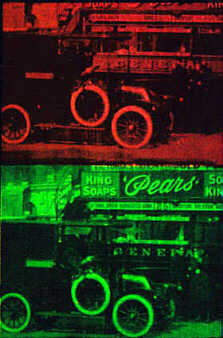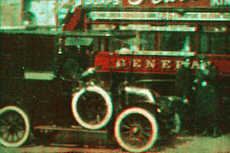

Stained frame printing eliminated the need for a rotating color filter in processes that used sequential color exposures. They also probably helped get around certain patents.
Biocolor, a system dating back to 1912, used a photographic system quite similar to Kinemacolor. The prints were then alternately stained with red and green dyes. More conventional, and less complex, projectors could be used but the downside of the system was that it was difficult to maintian constant density in the stain and the color would fluctuate.
A common trait shared by many of the systems that photographed multiple elements on the same film is the fact that the mechanical and optical components required to put the individual images on the film were physically too large to record exactly the same framing in each element. As seen in the red and green stained frames above, the optical centers of the two images are not aligned with the center if each frame. In this example we see that more of the lower part of the image is recorded in the red record and more of the top of the image is recorded in the green record. Areas that were unique to only one frame or the other had to be masked either at the projector or at the screen. In systems where the elements were recorded side by side, the width of each picture had to be masked to hide the unique areas.
As with all systems of this type, the quality of the projected image depended heavily on the projectionist to insure proper registration of the two separate images. The source of these frames is unknown.
Stained frame print images duplicated from The International Encyclopedia of Film © 1972 Rainbird Reference Books Limited, London. The composite color image was created at The American WideScreen Museum and Film Technology Center, Houston, Texas, U.S.A. ©1996, 1998
